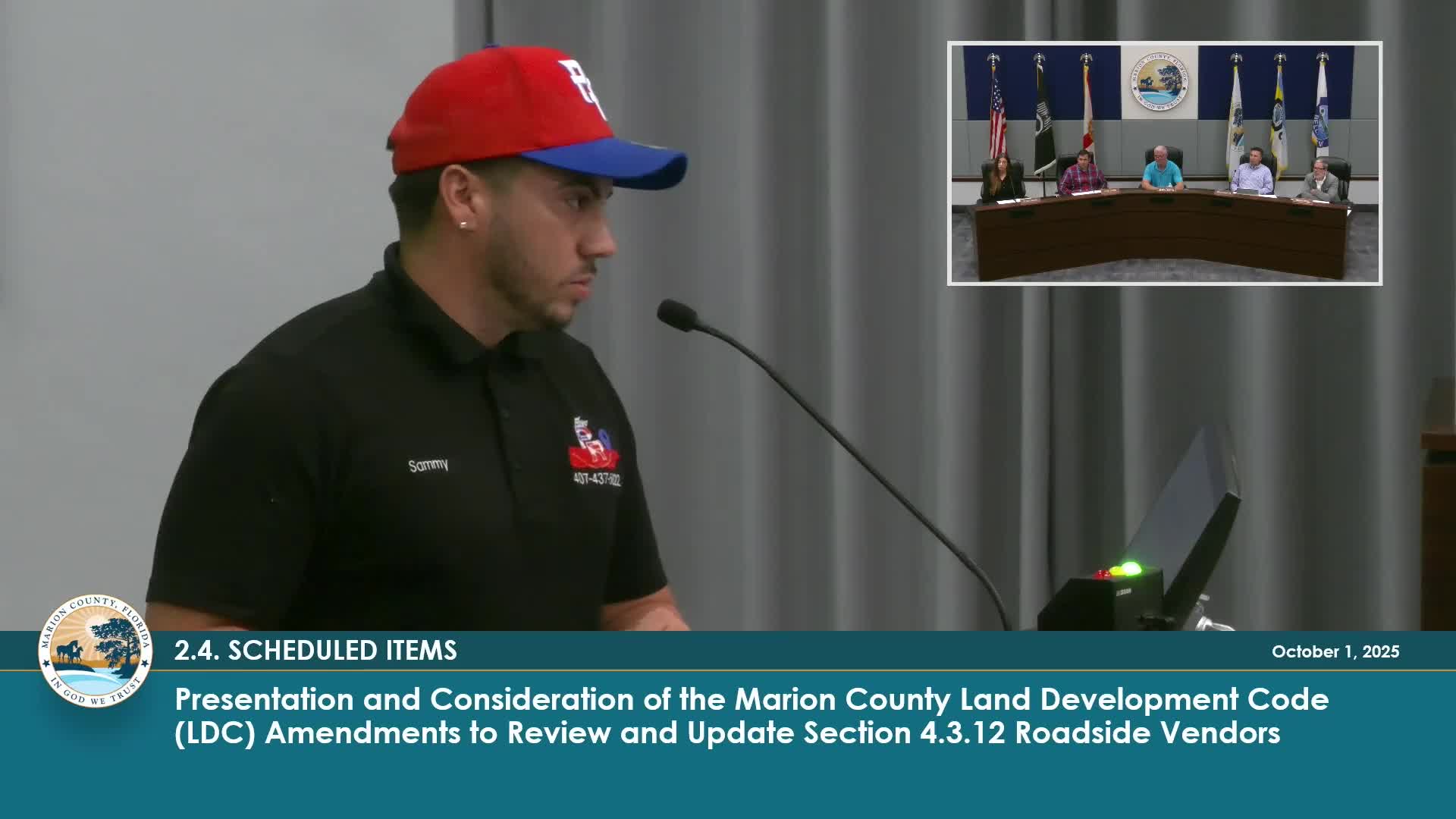LDRC approves new definitions to make 'big‑box' stores eligible for shopping‑center sign rules
October 01, 2025 | Marion County, Florida
This article was created by AI summarizing key points discussed. AI makes mistakes, so for full details and context, please refer to the video of the full meeting. Please report any errors so we can fix them. Report an error »

The Land Development Regulation Commission approved privately initiated amendments to the Marion County Land Development Code that add definitions for “big box retailer” and “shopping center” so that large single‑occupancy retail stores can be regulated under shopping‑center signage rules.
The change was proposed by an applicant represented by Stearns Weaver Miller; Jessica Iserman, the applicant’s attorney, spoke to the commission during the public hearing. Staff told the commission they had no objection and recommended approval. Commissioners voted to approve the two related items (definitions and sign‑code amendment) on a motion and voice vote.
Why it matters: The county’s existing sign code treats single‑occupancy buildings and multi‑tenant shopping centers differently for wall‑sign area calculations. Under current Marion County code, a single‑occupancy building is limited to a maximum of 96 square feet of wall signage (calculated at 2 square feet per linear foot of building frontage, with a 96‑square‑foot maximum). By contrast, shopping‑center wall signage is calculated at 1.75 square feet per linear foot of building frontage with no stated maximum.
What changed: The amendment adds a “big box retailer” definition and a shopping‑center definition to the code so that modern, large single‑occupancy retail stores — examples cited in the record include big‑box formats that house multiple departments under one roof — can be treated consistent with shopping centers when calculating allowable wall signage. Petitioners and staff said the change reflects how retail footprints have evolved; the amendment does not alter the numerical formula in the sign code but extends the shopping‑center method to qualifying big‑box retailers.
Process and public input: The applicant’s attorney described the operational need for the change and showed sample signage to illustrate the disparity between what large single‑occupancy stores commonly use and the current 96‑square‑foot cap. The commission opened public comment for both related items (2.1 and 2.2); no members of the public rose to speak on the sign‑code definitions. After brief discussion, a motion to approve carried on a voice vote.
Next steps: The LDRC’s approval will be transmitted to the Board of County Commissioners for its required public hearings. One LDRC member stated they intended to abstain from the vote on items 2.1 and 2.2 but the commission recorded adoption and will forward the recommendation to the BOCC.
The change was proposed by an applicant represented by Stearns Weaver Miller; Jessica Iserman, the applicant’s attorney, spoke to the commission during the public hearing. Staff told the commission they had no objection and recommended approval. Commissioners voted to approve the two related items (definitions and sign‑code amendment) on a motion and voice vote.
Why it matters: The county’s existing sign code treats single‑occupancy buildings and multi‑tenant shopping centers differently for wall‑sign area calculations. Under current Marion County code, a single‑occupancy building is limited to a maximum of 96 square feet of wall signage (calculated at 2 square feet per linear foot of building frontage, with a 96‑square‑foot maximum). By contrast, shopping‑center wall signage is calculated at 1.75 square feet per linear foot of building frontage with no stated maximum.
What changed: The amendment adds a “big box retailer” definition and a shopping‑center definition to the code so that modern, large single‑occupancy retail stores — examples cited in the record include big‑box formats that house multiple departments under one roof — can be treated consistent with shopping centers when calculating allowable wall signage. Petitioners and staff said the change reflects how retail footprints have evolved; the amendment does not alter the numerical formula in the sign code but extends the shopping‑center method to qualifying big‑box retailers.
Process and public input: The applicant’s attorney described the operational need for the change and showed sample signage to illustrate the disparity between what large single‑occupancy stores commonly use and the current 96‑square‑foot cap. The commission opened public comment for both related items (2.1 and 2.2); no members of the public rose to speak on the sign‑code definitions. After brief discussion, a motion to approve carried on a voice vote.
Next steps: The LDRC’s approval will be transmitted to the Board of County Commissioners for its required public hearings. One LDRC member stated they intended to abstain from the vote on items 2.1 and 2.2 but the commission recorded adoption and will forward the recommendation to the BOCC.
View full meeting
This article is based on a recent meeting—watch the full video and explore the complete transcript for deeper insights into the discussion.
View full meeting